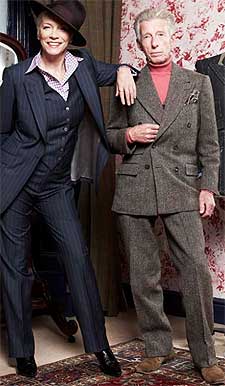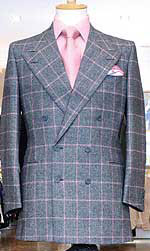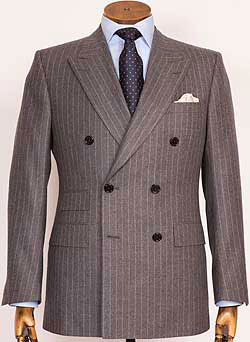|
HE-MAN RETURNS TO SAVILE ROW
Prince Charles may be a fan, but for many the formality of a double breasted suit has been out of favour for some time.
Yet, as we forecast last year, its re-emergence is well underway, as the inevitable swing of the style pendulum moves in its direction.
It certainly suggests greater formality, in that a d.b. jacket needs to be fastened or risk flapping unevenly. But as the d.b. blazer returns and d.b. casual jackets, younger men who have never before had a d.b. suit are now starting to appreciate its elegance.
Style figure Edward Sexton was wearing one at the recent Savile Row promotion, in a soft wool tweed. Simon Cundey of Huntsman was also resplendent in a Prince of Wales check suit, a three piece. And both looked perfectly elegant despite having the jackets undone.
Edward Sexton, right, wearing his tweed d.b. suit, with singer Annie Lennox, wearing a three piece suit made for her by him.
Past style icons who have shown the d.b. off to glamorous effect are Cary Grant,  the Duke of Windsor, Gary Cooper and George Raft – all now history and from an age when men dressed up. Perhaps renewed interest in d.b's indicates a new era for the male peacock, with the average man striving once more to look glamorous rather than just passable. Certainly, trends in jewellery and grooming (see Style p2) suggest such. the Duke of Windsor, Gary Cooper and George Raft – all now history and from an age when men dressed up. Perhaps renewed interest in d.b's indicates a new era for the male peacock, with the average man striving once more to look glamorous rather than just passable. Certainly, trends in jewellery and grooming (see Style p2) suggest such.
The Duke of Windsor, not a tall man, favoured the four button option, and helped make it popular in the 1940s. Hollywood took it up, showing it worn with elegant insouciance by Fred Astaire - and by a motley crew of gangsters in a range of B movies. Perhaps it was such criminal exposure that sent it into limbo.
This impeccable six-button d.b. is by Henry Poole, with a roped stripe and classic peaked lapels.
It returned in the 1980s, starting off reasonably enough but developing rapidly to extremes of comical delight. The worst excesses saw some examples  of eight even ten button styles being seen elsewhere but certainly not heard of in Savile Row. Coupled with outsize shoulders and shiny materials, it was hardly surprising that it went into limbo again. of eight even ten button styles being seen elsewhere but certainly not heard of in Savile Row. Coupled with outsize shoulders and shiny materials, it was hardly surprising that it went into limbo again.
Its re-emergence comes as a reaction to the slim and neat, even skimpy styles, that young fashionistas have been wearing. Tiny little jackets and slim pants may have received short shrift in Savile Row but their influence at a fashion level perculated out and kept the silhouette slim - until now.
A Richard Anderson d.b. in a grey tweed with pink overcheck, a wonderfully distinctive example.
A d.b. makes a he-man. It gives a bigger chest, with the top row of buttons taking the eye out and helping to give the impression of width. The skinny fashion kids are about to get bigger.
Taller men can get away with a six button style, which on a shorter figure can give  too much weight to the top half. And those with too much weight anyway should probably opt for the four button, or they can end up looking like a barrel of laughs. too much weight to the top half. And those with too much weight anyway should probably opt for the four button, or they can end up looking like a barrel of laughs.
Peaked lapels are traditional but not de rigueur. One of the young tailoring trainees at the Golden Shears awards wore a tweed d.b. with a narrow shawl collar, his own design which looked good, giving a long, low sweep to the d.b. fastening.
And just as peaked lapels are being applied to single breasted jackets, so plain notched lapels may be featured on d.b's.
Classic six-button style with the final button left undone, by Huntsman, in a grey stripe
|